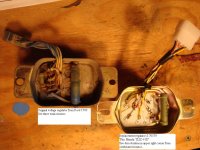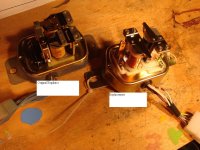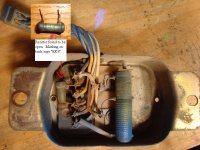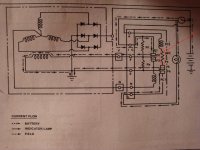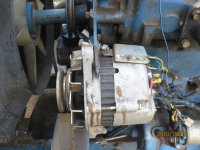Let me apologize up front for the length of this post. It's my first and I'm afraid I may have gone a bit overboard.
I've been fixing up my dad's old 1700 4WD. It's got over 2800 hrs and has been ridden pretty hard. From the advice I learned on TBN I've already changed out all the fluids. It still has a myriad of problems... but I want to focus on one at a time. The first one is an electrical issue.
The tractor always had a problem with the battery running down. The fix was to always pull the negative terminal off the tractor when you get finished for the day. My dad always said it was probably the voltage regulator. But I knew there must be a short or something discharging the battery, so I went through and traced out all of the wiring. I compared it to the diagrams in my shop manual (another whole story there...). I found an issue with the wiring going back to the hazard lights. Later on, I found that the alternator had a direct short from the A terminal to ground (which may or may not have been directly related to me accidentally reversing the polarity of the leads from a battery charger momentarily - the charger was unplugged at the time). I replaced the alternator with a Duralast 14105 from Autozone (I tried like heck to split the old alternator but could not for the life of me). New new one seems to be nearly identical. No more short.
After replacing the alternator I found that the voltage was not being regulated. I took readings of over 15.5v at the battery. The voltage kept increasing as I increased engine RPM. I determined that my dad was right - the regulator was bad. I searched online for a regulator (PN SBA185516030) and found several sites selling an aftermarket one, PN S.70579 made by Sparex. Upon receipt of the new VR I noticed that its construction was different from my old one. It had only one resistor, while the old one had 3.
OK. We're almost there. So I installed the new regulator, cranked up the tractor, and took voltage readings. Everything seemed great. I was happy to see readings from 14 to 14.5 volts even at around 2500 RPM. Just as I was patting myself on the back, I noticed little wisps of smoke from behind the fuel tank. I groaned and shut off the engine. Pulled the tank and looked at the regulator. I could see some discoloration in the metal near the resistor, but nothing else that looked burned. I mulled it over for a while. I talked myself into thinking that maybe it was just some manufacturing coating that was burning off. Maybe it was normal? So I pulled the regulator out and secured it to the top of the instrument panel so I could get a closer look at it with the engine running. Cranked it back up and measured the voltage. Still all good. I expected to see the relays on top of the VR chattering as they maintained the appropriate voltage, but I could not see them move at all. About a minute later I saw and smelled the smoke again. The resistor was indeed very hot.
I began to inspect the regulator more closely. On the outside it actually more closely resembles the VR for a Ford 1300 (according to my shop manual). Now, my shop manual also has the wiring schematic for the VR. My original VR matches it exactly. But the replacement one is far from the same.
1. Is it possible that the replacement regulator is supposed to be so different from the original? That they changed the internal wiring so much?
2. Is it possible that the VR is a red herring and the actual problem is the alternator I bought?
3. Do you have to polorize the generator when changing out regulators? I've read about having to do that on an 8N, but nothing on the 1700.
4. Anyone else run into anything similar?
Pics below of the old vs new regulators...
I've been fixing up my dad's old 1700 4WD. It's got over 2800 hrs and has been ridden pretty hard. From the advice I learned on TBN I've already changed out all the fluids. It still has a myriad of problems... but I want to focus on one at a time. The first one is an electrical issue.
The tractor always had a problem with the battery running down. The fix was to always pull the negative terminal off the tractor when you get finished for the day. My dad always said it was probably the voltage regulator. But I knew there must be a short or something discharging the battery, so I went through and traced out all of the wiring. I compared it to the diagrams in my shop manual (another whole story there...). I found an issue with the wiring going back to the hazard lights. Later on, I found that the alternator had a direct short from the A terminal to ground (which may or may not have been directly related to me accidentally reversing the polarity of the leads from a battery charger momentarily - the charger was unplugged at the time). I replaced the alternator with a Duralast 14105 from Autozone (I tried like heck to split the old alternator but could not for the life of me). New new one seems to be nearly identical. No more short.
After replacing the alternator I found that the voltage was not being regulated. I took readings of over 15.5v at the battery. The voltage kept increasing as I increased engine RPM. I determined that my dad was right - the regulator was bad. I searched online for a regulator (PN SBA185516030) and found several sites selling an aftermarket one, PN S.70579 made by Sparex. Upon receipt of the new VR I noticed that its construction was different from my old one. It had only one resistor, while the old one had 3.
OK. We're almost there. So I installed the new regulator, cranked up the tractor, and took voltage readings. Everything seemed great. I was happy to see readings from 14 to 14.5 volts even at around 2500 RPM. Just as I was patting myself on the back, I noticed little wisps of smoke from behind the fuel tank. I groaned and shut off the engine. Pulled the tank and looked at the regulator. I could see some discoloration in the metal near the resistor, but nothing else that looked burned. I mulled it over for a while. I talked myself into thinking that maybe it was just some manufacturing coating that was burning off. Maybe it was normal? So I pulled the regulator out and secured it to the top of the instrument panel so I could get a closer look at it with the engine running. Cranked it back up and measured the voltage. Still all good. I expected to see the relays on top of the VR chattering as they maintained the appropriate voltage, but I could not see them move at all. About a minute later I saw and smelled the smoke again. The resistor was indeed very hot.
I began to inspect the regulator more closely. On the outside it actually more closely resembles the VR for a Ford 1300 (according to my shop manual). Now, my shop manual also has the wiring schematic for the VR. My original VR matches it exactly. But the replacement one is far from the same.
1. Is it possible that the replacement regulator is supposed to be so different from the original? That they changed the internal wiring so much?
2. Is it possible that the VR is a red herring and the actual problem is the alternator I bought?
3. Do you have to polorize the generator when changing out regulators? I've read about having to do that on an 8N, but nothing on the 1700.
4. Anyone else run into anything similar?
Pics below of the old vs new regulators...
